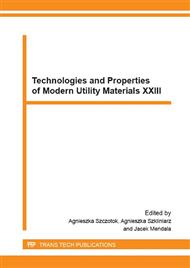p.47
p.51
p.55
p.59
p.63
p.67
p.71
p.75
p.81
The Use of Thermo-Gravimetric Studies for the Assessment of Technological Properties of Quartzites for the Ferrosilicon Smelting Process
Abstract:
The most objective methods of determining the usefulness of quartzite for the ferrosilicon smelting process are industrial research methods, but such studies are long-lasting and costly. In order to test the usefulness of thermo-gravimetric method to evaluate technological properties of quartzites in a laboratory, thermo-gravimetric studies of quartzites samples from various deposits were carried out. These quartzites are used or were used as a raw material in industrial ferrosilicon process. The study consisted of measuring the weight loss of powder samples in the form of mixture of quartz with graphite of molar ratio SiO2 + 3C during heating under an argon atmosphere in the temperature range up to 1500°C. The evaluation of technological properties of quartzites was done by comparing the curves of relative weight loss with industrial technological data of the ferrosilicon smelting process. It was established that the results of thermo-gravimetric studies show satisfying agreement with observations of industrial process, whereas quartzites of improved technological properties revealed a lower weight loss in thermo-gravimetric studies. Studies of this type can be useful as one of the methods of objective assessment of usefulness of quartzites for the ferrosilicon smelting process.
Info:
Periodical:
Pages:
63-66
Citation:
Online since:
February 2016
Authors:
Keywords:
Price:
Сopyright:
© 2016 Trans Tech Publications Ltd. All Rights Reserved
Share:
Citation:


